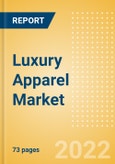Luxury apparel will recoup its losses from the pandemic by 2022 to reach sales of $149.2bn, driven by heightened demand in APAC and the Americas. Growth in APAC has been boosted by the rising number of middle class consumers and the shift to domestic purchasing due to COVID-19 international travel restrictions, while sales in the Americas have been bolstered by federal stimulus payments keeping demand for luxury goods high as many consumers invested in these items, such as handbags.
Formalwear-centric brands, such as Roberto Cavalli and Max Mara, suffered the most in 2020 as the pandemic led to an acceleration in the adoption of athleisure due to consumers preferring to wear comfortable clothing at home. In contrast, brands that were early adopters of the streetwear and athleisure trends, such as Dior and Louis Vuitton, were more resilient as they benefitted from front-of-mind appeal. Luxury brands must continue to incorporate more casual styles in their products to remain relevant and appeal to Gen-Z consumers in particular, as these shoppers have become a crucial demographic within the luxury sector.
International luxury brands must acknowledge the shopping behaviors and preferences of APAC consumers when considering their growth strategies, as the region is expected to make up 40.7% of the luxury apparel market by 2025, up from 37.9% in 2019. This equates to a forecast value of $71.6bn in 2025 and a CAGR of 9.6% between 2020-2025, so a strong performance in this region will boost brands’ fortunes.
This report provides an overview of the global luxury fashion retailing which includes key trends, key retail innovations, regional and sector analysis along with major luxury fashion retailers and competitive land scape
Formalwear-centric brands, such as Roberto Cavalli and Max Mara, suffered the most in 2020 as the pandemic led to an acceleration in the adoption of athleisure due to consumers preferring to wear comfortable clothing at home. In contrast, brands that were early adopters of the streetwear and athleisure trends, such as Dior and Louis Vuitton, were more resilient as they benefitted from front-of-mind appeal. Luxury brands must continue to incorporate more casual styles in their products to remain relevant and appeal to Gen-Z consumers in particular, as these shoppers have become a crucial demographic within the luxury sector.
International luxury brands must acknowledge the shopping behaviors and preferences of APAC consumers when considering their growth strategies, as the region is expected to make up 40.7% of the luxury apparel market by 2025, up from 37.9% in 2019. This equates to a forecast value of $71.6bn in 2025 and a CAGR of 9.6% between 2020-2025, so a strong performance in this region will boost brands’ fortunes.
This report provides an overview of the global luxury fashion retailing which includes key trends, key retail innovations, regional and sector analysis along with major luxury fashion retailers and competitive land scape
Scope
- The luxury sector will grow beyond pre-pandemic levels in 2022, driven by sustained domestic demand in APAC and the Americas
- Luxury brands must incorporate more casual styles, including athleisure and streetwear, to remain relevant to the post-pandemic shopper
- Asian consumers will continue to drive the luxury apparel market out to 2025
Reasons to Buy
- Gain a comprehensive knowledge on Global Luxury fashion market and develop a competitive advantage
- Investigate current trends in the global luxury fashion market to identify the best opportunities to exploit
- Analysis of key luxury fashion players operating globally
- Explore novel opportunities that will allow you to align your product offerings and strategies to meet demand by analyzing the key consumer and technology trends influencing the luxury fashion market globally
- Analyze the recommended actions to align your marketing strategies with the crucial trends influencing consumer behavior
- Analysis of key international players operating in global luxury fashion retail market - including store counts and revenues that give you a competitive edge and identify opportunities to improve your market share
Table of Contents
- Executive Summary
- Key Trends in the Luxury Apparel Market
- Global Market Size & Forecasts 2020 2025
- Regional Performance & Forecasts 2020 2025
- Category Performance & Forecasts 2020 2025
- Competitive Landscape: Top 20 Brands
- Competitive Landscape: Brand Profiles
- Appendix
- Methodology, Definitions & Contacts
Companies Mentioned (Partial List)
A selection of companies mentioned in this report includes, but is not limited to:
- Gucci
- Louis Vuitton
- Chanel
- Hermès
- Dior
- Burberry
- Saint Laurentt
- Fendi
- Moncler
- Prada








